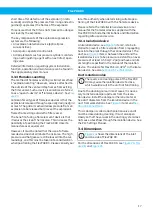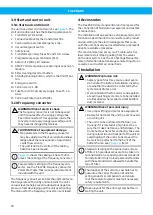
FlexPAK DX
3.2.1 Permitted materials
WARNING! Explosion risk
• Do not collect material that may cause igni-
tion or blocking. It is strictly prohibited to col-
lect material that may undergo dangerous
chemical or thermal reactions and/or self-ig-
nite.
• Do not make any changes to this product
without consulting Nederman. Adding a relief
duct or changing the spacing or length of fil-
ter elements affects the calculations accord-
ing to EN 14491.
• The filter should not be used for filtering
fumes from welding processes.
WARNING! Risk of personal injury
Use suitable protective equipment: goggles,
ear protection and a protective mask.
It is of the utmost importance to know the
properties of the extracted material.
Some materials may undergo chemical reac-
tions in combination with humidity/water.
Such humidity may, for example, form if the
humidity in the extracted air is condensed in
the filter.
FlexPAK DX is intended to be a part of an extraction
system collecting material with the following proper-
ties:
• MIE (Minimum Ignition Energy): See the product
identification plate.
• MIT (Minimum Ignition Temperature): See the
product identification plate.
• Kst: See the product identification plate.
• Pmax: See the product identification plate.
Materials with properties not within the values stated
above or if a suppression or flameless system is used
are to be investigated prior to use with FlexPAK DX.
Contact Nederman for technical support and dust ap-
plication investigation.
3.3 Explosion protection
The CE and ATEX markings on this unit ensure both a
high level of safety and protection against ignition of
the collected combustible dust. However, if an explo-
sion occurs due to misuse, insufficient maintenance or
faulty installation, this unit is equipped with addition-
al protection methods to avoid dangerous pressure
build-up in the filter.
FlexPAK DX is equipped with one of the following pro-
tection systems.
• Explosion venting, see
• Explosion suppression system, see
.
3.3.1 Explosion venting
The risk area may extend beyond the values
given below. The final risk area is to be evalu-
ated with regards to affecting factors found in
Standard EN 14491.
For assistance and information, contact Neder-
man.
The harmful effects of an explosion are minimized
by venting the pressure and flame of the explosion
through an explosion relief panel, see
case of an explosion, the resulting flame and pressure
escape through the explosion relief panel which is to
be directed towards a safe area without any people.
This area is referred to as the ‘risk area’.
The risk area is to be clearly marked, for example with
a fence, warning lines and signs, and entry is prohib-
ited when the filter is in operation. Anyone operat-
ing in the vicinity of the risk area must be informed
of the risks. The area is to be free of any flammable
or combustible material or other objects which may
be damaged by the flames and explosion pressure. It
is advisable to use a deflector to direct the risk area
away from areas where persons may be present. The
unit shall be placed so that all operations may be per-
formed without entering the risk area.
The general size of the risk area with or without de-
flector (accessory) is shown in
. As a general rule the following dimensions ap-
ply:
A 10 m (32,8 ft)
B 4 m (13,1 ft)
C 2,5 m (8,2 ft)
D 5 m (16,4 ft)
E 5 m (16,4 ft)
F 5 m (16,4 ft)
G 1 m (3.3 ft)
H 0,5 mm (1.7 ft)
I
0,7 m (2.3 ft)
J
5 m (16,4 ft)
In some cases, it is necessary to use a duct on the ex-
plosion relief panel to vent the flame and pressure to
a proper safe area. Such a duct is to be able to with-
stand an overpressure of at least 0,5 bar (5,8 psi).
A vented duct affects the efficiency of venting
so the efficiency needs to be calculated. Con-
tact Nederman for assistance.
3.3.2 Explosion suppression system
With an explosion suppression system, the early stage
of an explosion is detected with optical and/or pres-
sure-sensitive devices, and an extinguishing agent
is quickly dispersed into the filter, see
suppression of the explosion is initiated an extremely
16
Summary of Contents for FlexPAK DX
Page 7: ...FlexPAK DX A E E A B C D G F 3A J I H 45 3B 7 ...
Page 8: ...FlexPAK DX 13 12 10 9 7 8 2 1 3 4 6 5 11 4A 11 7 8 9 12 13 15 14 17 16 10 18 4B 8 ...
Page 10: ...FlexPAK DX 6 A B 7 10 ...
Page 13: ...FlexPAK DX 11 12 13 14 13 ...
Page 14: ...FlexPAK DX A A A A C Min 2 1m 83 15 1 0 m 39 4 16 A B C 17 14 ...
Page 36: ...www nederman com ...





































